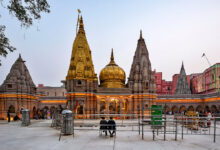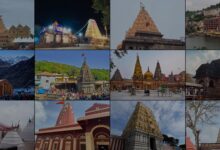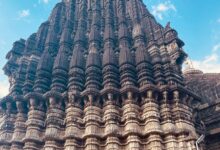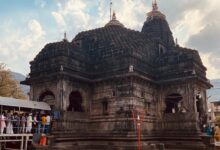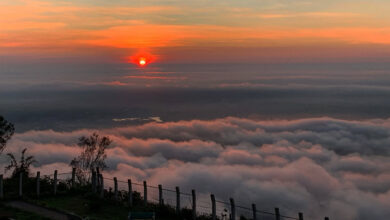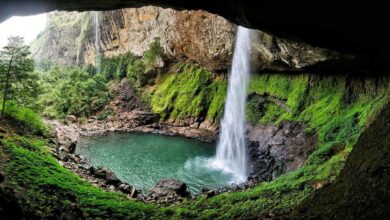Trimbakeshwar Jyotirlinga Shiv Temple in Nashik
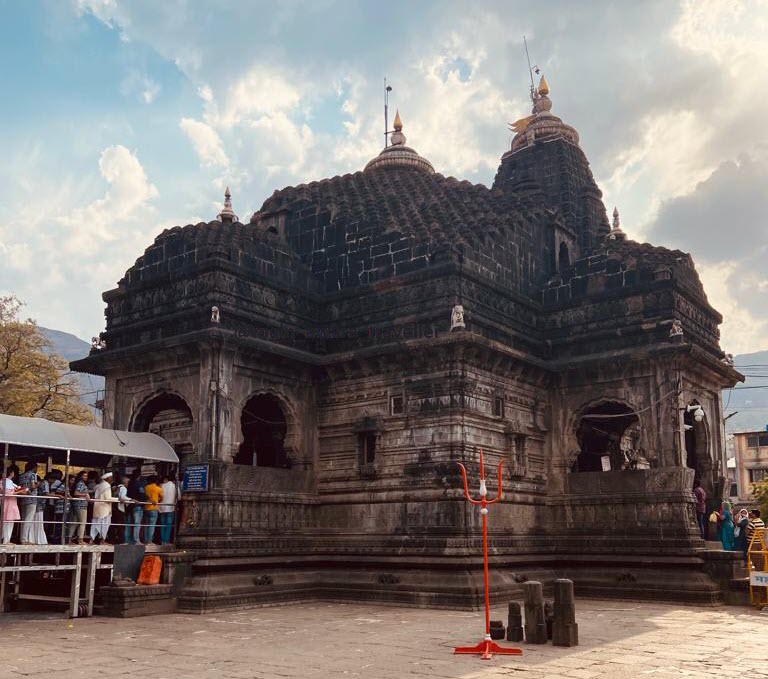
|
Getting your Trinity Audio player ready...
|
The word ‘Jyotirlinga’ is derived from two Sanskrit words, ‘Jyoti’ meaning ‘radiance’ and ‘linga’ meaning ‘mark’ or ‘sign’. Together, Jyotirlinga means ‘radiant sign’ or ‘radiant symbol’ of Lord Shiva. It is believed that there are twelve Jyotirlingas in India, which are considered to be the most sacred abodes of Lord Shiva.
Each Jyotirlinga has a unique story and significance associated with it, and devotees from all over the world come to pay their respects and seek blessings from Lord Shiva.
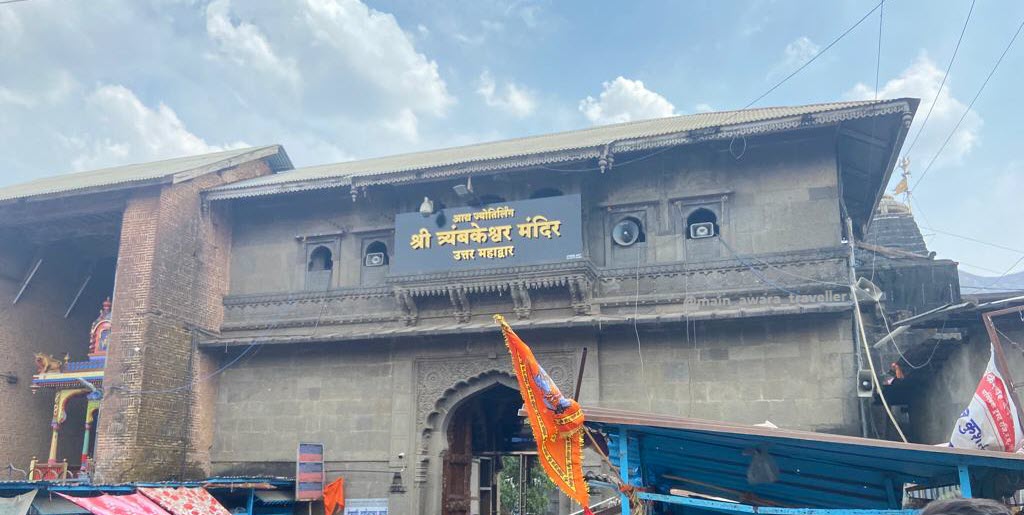
Also Read : Omkareshwar Jyotirlinga Temple On Banks Of Narmada
Unique features of Trimbakeshwar Jyotirlinga
One of the most unique features of Trimbakeshwar Jyotirlinga is the presence of three lingas (phallic symbols representing Lord Shiva) inside the temple. The first linga represents Lord Brahma, the second represents Lord Vishnu and the third represents Lord Shiva himself.
The lingas are covered with gold, silver and copper respectively, and are adorned with various precious stones. It is believed that offering prayers to these three lingas is equivalent to worshipping all three deities.
Trimbakeshwar Jyotirlinga is also famous for its association with the Kumbh Mela, which is one of the largest religious gatherings in the world. The Kumbh Mela is held once every 12 years in four different locations in India, including Trimbakeshwar.
Millions of devotees from all over the country come to Trimbakeshwar to take a holy dip in the Godavari river and to seek blessings from Lord Shiva.
Story behind Trimbakeshwar Jyotirlinga?
According to mythology, the sage Gautama lived on the Brahmagiri hills with his wife, Ahilya. The area was plagued by a severe drought, causing a severe famine for 24 years. Gautama Rishi sowed rice in the surrounding fields of his ashram, and Lord Varuna, pleased with his devotion, made it rain heavily in Trimbakeshwar.
Due to Gautama’s regular prayers and steadfast devotion, God blessed him with abundant food grains. He reaped the crop in the afternoon and fed it to the Rishis who took shelter in his ashram. Because of his generosity, Gautama Rishi’s merit or Punya increased, which made Lord Indra jealous.
Lord Indra ordered clouds to rain all over Trimbakeshwar to end the famine, but Gautama Rishi requested all Rishis to stay back and continued to feed them. The other Rishis felt jealous of him and sent a cow to Gautama Rishi’s field. When Gautama Rishi tried to frighten the cow away from his fields, the cow died. It was later revealed that the cow was the form of Jaya, Goddess Parvati’s friend.
To absolve himself of his sin, Gautama Rishi worshipped Lord Shiva and requested him to release the Ganga River so that he could take a bath in it. Lord Shiva released Ganga and asked her to stay there, and the Kushavarta Pond that exists now in Godavari River is worshipped as Ganga.
All the Rishis requested Lord Shiva to stay there, which he did in the form of Trimbakeshwar Jyotirlinga.
The temple was constructed by Peshwa Balaji Baji Rao in the 18th century, and it is one of the most famous and revered temples in India. People believe that taking a dip in the holy waters of Godavari River and offering prayers at the temple can absolve one of their sins and bring blessings to their lives.
Architecture Of Trimbakeshwar Jyotirlinga
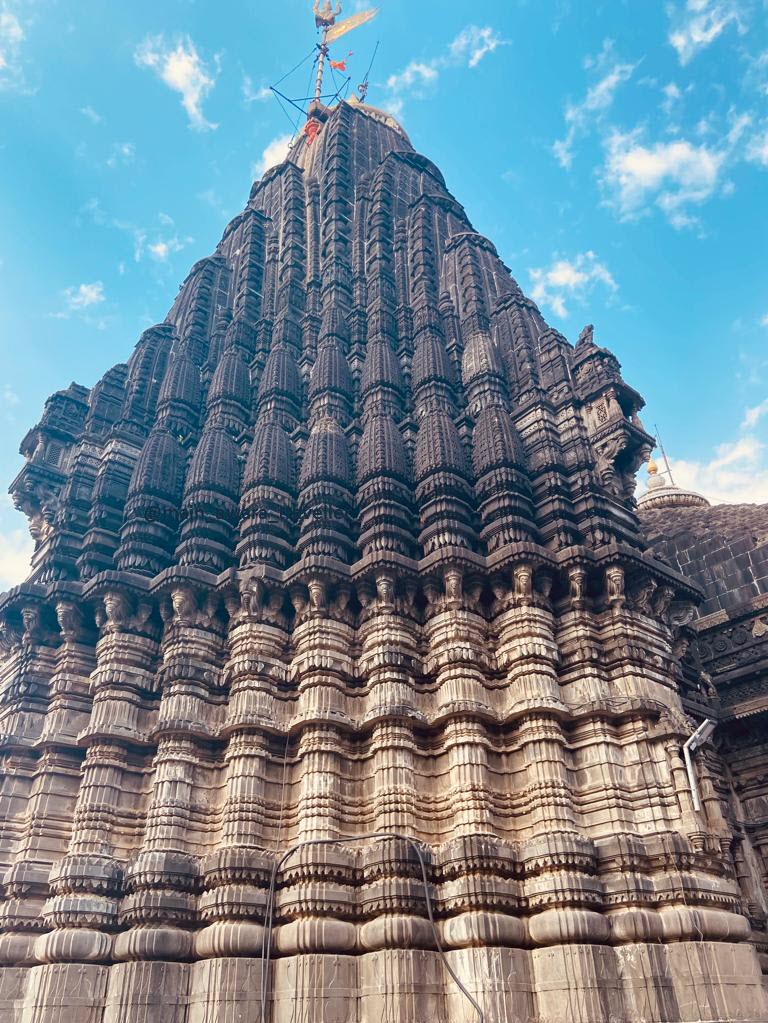
The temple’s architecture is a blend of the ancient and modern styles. The temple complex consists of three main structures – the main temple, the mandap (prayer hall) and the Kunda (sacred pool). The main temple is built in the Nagara style of architecture, which is prevalent in the north of India.
The temple is made of black stone and has a beautiful spire that rises up to a height of 20 meters. The mandap is a large open hall where devotees can offer their prayers and perform religious rituals. The Kunda is a sacred pool where devotees can take a dip to purify themselves before entering the temple.
How to Reach Trimbakeshwar Jyotirlinga?
Located in the town of Trimbak, near Nashik in the western state of Maharashtra, which is abput 28 km from the city of Nashik and 40 km form the Nashik Road.
The temple is located between the three hills, Kalagiri, Nilagiri and Brahmagiri.
Trimbakeshwar Jyotirlinga By Air
The nearest airport to Trimbakeshwar is the Ozar Airport in Nashik, which is about 30 km away. From the airport, you can hire a taxi or take a bus to reach Trimbakeshwar.
Trimbakeshwar Jyotirlinga By Train
The nearest railway station to Trimbakeshwar is the Nashik Road Railway Station, which is about 28 km away. From the railway station, you can take a taxi or bus to reach Trimbakeshwar.
Trimbakeshwar Jyotirlinga By Bus
Trimbakeshwar is well-connected by road and you can easily reach here by bus. Maharashtra State Road Transport Corporation (MSRTC) operates regular bus services from major cities in Maharashtra to Trimbakeshwar.
Trimbakeshwar Jyotirlinga By Car
You can also hire a private car or taxi to reach Trimbakeshwar from nearby cities like Nashik, Mumbai, or Pune.
It is advisable to check the weather conditions and road conditions before planning your trip to Trimbakeshwar.
Best time to visit Trimbakeshwar Jyotirlinga?
The best time to visit Trimbakeshwar is during the winter season, from November to February, as the weather is pleasant and cool during this time. The temperature ranges from 10°C to 25°C, making it ideal for sightseeing and outdoor activities.
Another good time to visit Trimbakeshwar is during the monsoon season, from June to September, as the surrounding hills and forests come alive with lush greenery, and the waterfalls in the area are at their best.
However, it is advisable to avoid visiting Trimbakeshwar during the summer season, from March to May, as the temperature can soar up to 40°C, making it uncomfortable for tourists to explore the place.
Also, it is important to note that Trimbakeshwar attracts a large number of devotees during the Mahashivaratri festival, which usually falls in February or March. So, if you are planning to visit during this time, be prepared for large crowds and long waiting times for darshan.
Places to visit Near Trimbakeshwar Jyotirlinga?
- Pandavleni Caves
- Ramkund
- Anjaneri Fort
- Kalaram Temple
- Someshwar Waterfall
- Someshwar Mahadev Nashik
- Coin Museum
- Brahmagiri
- Harihar Fort
Conclusion
In conclusion, Trimbakeshwar Jyotirlinga is an important pilgrimage site for Hindus and is revered for its unique architecture and religious significance. Its association with the Kumbh Mela makes it even more special, and millions of devotees flock to the temple to seek blessings from Lord Shiva. If you are planning a trip to India, Trimbakeshwar Jyotirlinga should definitely be on your list of places to visit.

